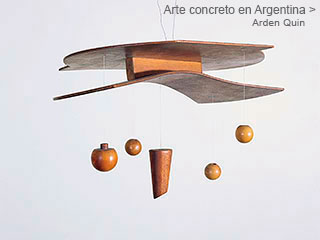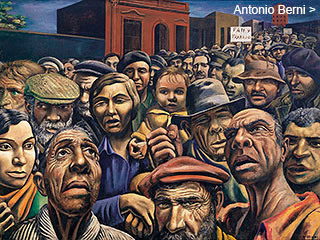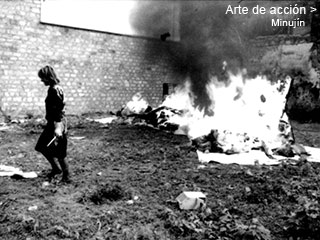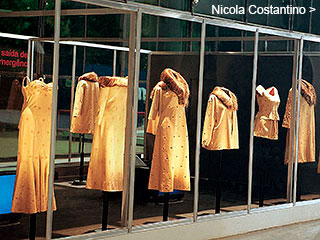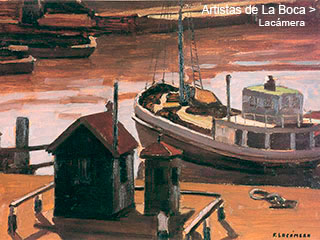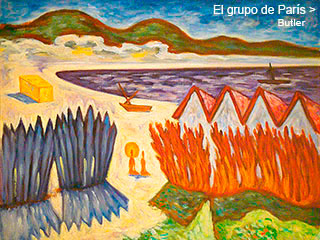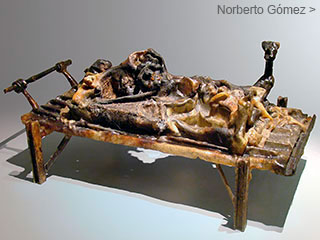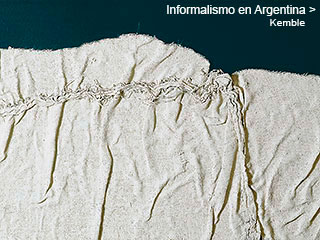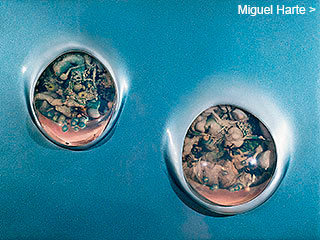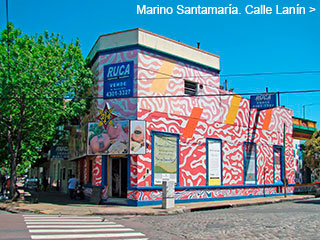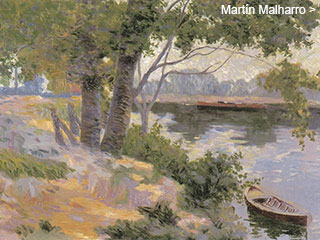Menú
Algunos dossiers
Concrete Art
in Argentina
in Argentina
by
Adriana Lauria
January 2003
January 2003
Abstraction asserted itself in Argentina through the achievements of groups such as Arte Concreto-Invención, Madí and Perceptismo, which developed their activity since the second half of the 1940s. These groups constituted the first organized national avant-garde and made their aesthetics known to the public through exhibitions, magazines, manifestoes, leaflets, lectures, etc.
Documents
White Manifesto
Manifiesto blanco (White Manifesto). Opuscule published by Lucio Fontana’s pupils at the Escuela de Arte Altamira (Altamira School of Arts), Buenos Aires, 1946.
Art is now in a period of latency. There is a strength that man cannot express. We express it in a literal way in this manifesto.
So we ask to all the men of science in the world who know that art is a vital need of the species to dedicate part of their researches towards the discovery of that luminous, malleable substance and of the instruments that will utter sounds, which will allow the development of the tetradimensional art.
We will provide the researchers with the necessary documents.
Ideas are not to be contested. They are latent within society, then thinkers and artists express them.
All things spring up out of need and are worthy in their time.
Transformations in life’s material means determine man’s psychical states through history.
The system that rules civilization from its origins changes.
Its place is gradually taken by the opposite system in essence and in every way. All conditions of the life of society and of each individual will change. Each man will live according to an integral organization of work.
The unrestrained findings of science gravitate on that new organization of life.
The discovery of new physical forces, the power on matter and space gradually impose to man conditions that have not existed in the whole history.
The implementation of those discoveries in all ways of life causes an alteration in man’s nature. Man adopts a different psychic structure.
We live the age of mechanics.
Painted cardboard and erected plaster are already senseless.
Since the known forms of art were discovered in different moments of history, within each art takes place an analytic process. Each of those forms had its arrangement system, independent from the others.
All possibilities were found and developed, all that could be expressed was expressed.
Identical conditions of spirit were expressed in music, in architecture, in poetry.
Man split his energies into different manifestations in response to such a need of knowledge.
Idealism was practiced when existence could not be explained in a concrete way.
The mechanisms of nature were ignored. The processes of intelligence were known. Everything was laid upon the possibilities inherent to intelligence. Knowledge consisted of messy speculations that very seldom reached a truth.
Plastics consisted of ideal representations of the known forms, of images to which reality was ideally ascribed. The spectator imagined one object behind another, he imagined the difference between the muscles and the represented clothes.
Today, experimental knowledge replaces imaginative knowledge. We are conscious of a world that exists and explains by itself, and that cannot be modified through our ideas.
We need an art valid by itself. With no intrusion of the ideas we might have about it.
Materialism established in every conscience demands an art in possession of its own values, afar from a representation that today means farce. Forged within this materialism, we men of this century have become insensitive as to the representation of known forms and the telling of experiences constantly repeated. Abstraction was conceived, after being gradually reached through distortion.
Yet this new status does not meet the demands of man in our day.
A change in essence and in form is required. The surmounting of painting, of sculpture, of poetry, of music is required. A major art according to the demands of the new spirit is needed.
The fundamental conditions of modern art are clearly noted from the XIII century, when the representation of space begins. The great masters successively appearing set off this tendency. Space is represented with increasing amplitude for centuries.
The Baroques take a leap in this sense: they represent space with grandiosity not superseded yet and they add to plastics the notion of time. The figures seem to abandon the plane and continue in space the represented motions.
This conception was a consequence of the concept of existence that was shaping in man. For the first time, the physics of the moment explained nature through dynamics. It is determined that motion is a condition immanent to matter as a principle of the understanding of universe.
On reaching this stage of evolution, the need for motion is so big that it cannot be matched by plastics. Then the evolution is continued through music. Painting and sculpture enter the Neo-Classicism, a true swamp in the history of art, and they are nullified by the art of time. Once the time was conquered, the need for motion expressed itself fully. The progressive liberation from canons gave music a gradually increasing dynamism (Bach, Mozart, Beethoven). Art continues to develop in the sense of motion.
Music maintained its prevalence for two centuries and since Impressionism it develops parallel to plastics. SINCE THEN THE EVOLUTION OF MAN IS A MARCH TOWARDS MOTION DEVELOPED IN TIME AND SPACE. IN PAINTING, THE ELEMENTS NOT ALLOWING THE IMPRESSION OF DYNAMISM ARE GRADUALLY SUPPRESSED.
The impressionists sacrificed drawing and composition. In Futurism some elements are removed and others lose their importance, being subordinated to sensation. Futurism adopts motion as unique principle and unique end. Cubists deny that their first painting was a dynamic one; the essence of Cubism is the vision of nature in motion.
When music and plastics assemble their development in Impressionism, music bases upon plastic sensations, painting seems to be melting in an atmosphere of sound. In most of Rodin’s works we note that volumes seem to rotate in that same atmosphere of sound. Their conception is essentially dynamic and many times it reaches the exacerbation of motion. Lately, has it not been intuited “the shape” of sound? (Schoenberg) or a superposition or co-relation of “sound planes”? (Scriabin). The similitude between Stravinsky’s forms and the measuring of planes’ areas in Cubism is evident. Modern art endures a transition in which a break with previous art is demanded in order to make place for new conceptions. As seen through a synthesis, this status is the passage form immobility to dynamics. Seized in such transition, art could not come away from its Renaissance inheritance. The same stuffs and the same disciplines were used to express an entirely transformed sensitivity. The ancient elements were employed in an opposite sense. Reverse forces struggled against each other. The known and the unknown, future and past. That is why tendencies sustained upon opposite values and pursuing seemingly different goals multiplied. We collect that experience and project it towards a clearly noticeable future. Aware or not aware of that research, modern artists could not reach a similar result. They did not have the required technical means to impart motion to bodies; they only did it in an illusory way, representing motion through conventional means.
The need of new technical materials to achieve the aimed goals is thus determined. Associated to the development of mechanics, this circumstance has generated the cinema, and its success is a new evidence of the course taken by spirit towards the dynamic.
MAN IS EXHAUSTED OF THE PICTORIAL AND SCULPTURAL FORMS. THEIR OWN EXPERIENCES, THEIR OPPRESSIVE REPETITION TESTIFY THAT THESE ARTS REMAIN STAGNANT IN VALUES ALIEN TO OUR CIVILIZATION, WITH NO POSSIBLE DEVELOPMENT IN THE FUTURE.
Peaceful life has disappeared. The idea of fastness is a constant in man’s life.
The artistic age of paralytic shapes and colors takes to an end. Man turns gradually insensible to fixed images with no signs of liveliness. Ancient immobile images do not meet the appetites of the new man, shaped in the need for action, in coexistence with mechanics, which compels him to a continuous dynamism. The aesthetics of organic motion replaces the worn out aesthetics of fixed forms.
Invoking this mutation occurred in the nature of man in his psychic and moral changes and in every human relation and activity, we abandon the practice of the known forms of art and we board the development of an art based upon the unity of time and space.
The new art takes its elements from nature.
Existence, nature and matter are a perfect unit. They develop in time and space.
Change is the essential condition of existence. Motion, the property to evolve and develop is the basic condition of matter. This exists only in motion and not in any other ways. Its development is eternal. Color and sound are found in nature, connected to matter.
Matter, color and sound in motion are those phenomena the simultaneous development of which the new art integrates.
Color in volume developing through space adopting successive forms. Sound uttered by still unknown appliances. Musical instruments do not meet the need for a vast sonority neither produce sensations in the required amplitude.
The construction of voluminous shapes in mutation through a plastic and mobile substance.
Arranged in space they act synchronically, they integrate dynamic images.
Thus, we exalt nature in its full sense.
Matter in motion expresses its entire, everlasting existence, developing in time and in space, adopting throughout its mutation different status of existence.
We conceive man reencountering nature, in his need to be connected with it as to retrieve the exercise of his original values. We postulate a thorough understanding of the primary values of existence, so we establish in art the substantial values of nature.
We exhibit the substance, not the accidents. We do not represent man, nor the other animals neither the other forms. These are manifestations of nature, mutable with time, which change and disappear depending on the succeeding of phenomena. Their physic and psychic conditions are subject to matter and the evolution of it. We head to matter and its evolution, the generating sources of nature.
We take the energy inherent to matter, its need of being and developing.
We postulate an art free from any aesthetical artifice. We practice what there is of natural, of true in man. We reject the aesthetical deceits made up by speculative art.
We stand closer from nature as never before art has been in history.
To love nature does not prompt us to copy it. The sense of beauty that brings us the form of a plant or a bird or the sexual feeling that brings us a woman’s body, develop and act in man according to his sensibility. We reject those particular emotions that certain forms produce in ourselves. Our aim is to approach in a synthesis all the experiences of man, which joined to the function of his natural conditions, constitute a manifestation inherent to the human being.
We take as a principle the first artistic experiences. Men in Prehistory, who perceived for the first time a sound created through beats applied on a hollow body, were subjugated by their rhythmic combinations. Stimulated by the suggestive strength of rhythm they must have danced until ecstasy. Everything was sensations with primitive men. Sensation in front of an unknown nature, musical sensations, rhythm sensations.
Our aim is to develop that original condition in man.
The subconscious, a magnificent receptacle were all the images perceived by the mind stay, adopts the essence and the shapes of those images, it lodges the notions that inform the nature of man. So, when the objective world changes, what the subconscious assimilates also changes, which causes modifications in man’s ways of conceiving things.
The historical inheritance received from previous stages of civilization and the adjustment to new conditions of life take effect through the function of the unconscious. The subconscious moulds the individual, it integrates him, and it transforms him. It provides him with the array received from the world and which the individual adopts. All artistic conceptions are due to the function of the subconscious.
Plastics developed according to the forms of nature. The expressions of the subconscious were entirely adapted to them due to the idealistic conception of existence.
Materialist consciousness, that is to say, the need for clearly provable things, demands that art forms rise directly from individuals, suppressing the adjustment to natural forms.
An art based on forms created by the subconscious, balanced by reason, constitutes a true expression of the being and a synthesis of a historic moment.
The stance of rationalist artists is a false one. In their struggle to impose reason and deny the function of the subconscious, they only achieve a less visible presence of it. In every one of their works we find this faculty to have worked. Reason does not create. In the creation of forms, its function subordinates to the one of the subconscious.
In all his activities man works with the whole of his abilities. The free development of them all is an essential condition in creation and in the elucidation of the new art. Analysis and synthesis, meditation and spontaneity, construction and sensation are values that attend their integration in a functional unit. And their development through experience is the only way that leads to a full manifestation of the being.
Society suppresses the division between its strengths integrating them into a unique more vigorous strength. Modern science bases upon the progressive amalgamation of its elements.
Humanity integrates its values and its knowledge. This is a move deeply rooted in history through various centuries of development.
From this new status of consciousness stems an integral art in which the being functions and expresses him thoroughly.
After different millennia of analytic artistic development, there arrives the time for synthesis. Before, the division was a need. Today, it represents a disintegration of the conceived unit.
We conceive synthesis as an addition of physical elements: color, sound, motion, time, space, integrating a physical-psychic unit. Color, the space element, sound, the time element, and the motion that develops in time and space are the fundamental forms of the new art, which contains the four dimensions of existence. Time and space.
The new art requires the function of all the energies of man, in creation and interpretation. The being expresses integrally with the whole of its vitality.
Bernardo Arias - Horacio Cazeneuve -
Marcos Fridman - Pablo Arias - Rodolfo Burgos - Enrique
Benito - César Bernal - Luis Coll - Alfredo Hansen - Jorge Rocamonte.
COLOR. SOUND. MOTION.


